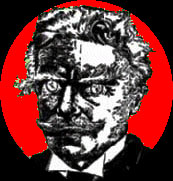 |
the AMBROSE BIERCE site |
Getting the marker dedication off the ground wasn't easy. Due to various conflicts, the ceremony was put off from the previous month. When the date finally arrived it poured, and Billi Bentley, Meigs County tourism coordinator, says the some 240 students and guests were forced to take shelter in the school gymnasium. Further, the ceremony was delayed due to the late arrival of Phil Ross, markers program coordinator for the Ohio Bicentennial Commission, which is responsible for putting up markers to various famous Ohioans around the state. It was Ross who wrote the text on the marker, which reads:
 On the far right is Phil Ross of the Ohio Bicentennial Commission. Photo by Billi Bentley. Dedication of the marker was previously caught up in a mini-controversy when Margaret Parker of the Meigs County Historical Society broached the notion Bierce may actually have been born in Akron, so she journied to that northern Ohio city on a fact-finding mission to prove her theory. However, Parker was confronted with convincing documentation suggesting Bierce was not born near Akron. Among the records were Civil War enlistment and pension records in which Bierce himself cited Meigs as "his nativity." Back in Meigs, Mary Powell of the (neighboring but not necessarily competing) Chester-Shade Historical Association (Chester for the township, Shade for the nearby river) found the tax record ledger for 1844, showing that the Bierce family did, indeed, live in Chester Township, Meigs County, and in 1843 paid taxes on two horses, three cows, plus a road levy, all in the amount of $1.60. The ledger, technically the property of Meigs County, had been stored, all but forgotten, in a building adjoining the old Chester Court House (1823), which was the county's original court house until the courts were moved to Pomeroy, Ohio, in 1841. Parker, incidentally, did not attend the marker dedication.
The site of Pomeroy was a mere village in 1806, and it wasn't until 1830 that its namesake, Samual Willys Pomeroy, arrived to establish the coal and salt mines which would turn the village into a prosperous industrial town. Eventually, Ohio's coal mines played out and salt is no longer a major Ohio commodity. When Bierce was born in Meigs in 1842, the county had a population of under 12,000. By 1880 the population had nearly doubled to approximately 23,000. But by 2003 it had dropped to only about13,000 -- nearly the same as the date of Bierce's birth. When Bierce was a child, his family moved to Indiana. During the Civil War Bierce was a member of Company C, 9th Indiana Infantry Volunteers. In 1863, the year Bierce was promoted to a first lieutenant and fought in the battles of Chickamauga and Missionary Ridge, a Rebel general, John H, Morgan, with about 2000 men, invaded Ohio via Indiana. Near Portland, Meigs County, Morgan's Raiders were confronted by 4000 Union troops led by General Henry M. Judah. Two future presidents, Rutherford B. Hayes and William McKinley, were among the Union forces involved in the battle, the only Civil War engagement to be fought in Ohio or north of the Ohio River. The Union troops captured 700 rebels, and the remaining Confederates scattered, some across the river into West Virginia. Morgan himself was captured near the Muskingum River as he retreated up the Ohio. He was taken to the Ohio Penitentiary in Columbus, escaped, made his way by freight train to Cincinnati, where he swam the Ohio to safety in Kentucky. There is an unresolved question as to whether Bierce, whose Civil War tales are without peer, was an anti-war writer. Certainly he depicted the horrors of war graphically, especially for the time, and his stories are as readable today as when they were first written. But Bierce loved military life and desperately wanted a commission after the war ended. He was intrigued by the strategies of conflict, placing one army against another in the way of a chess game. That he failed to win his commission was a victory for the reader, for military men are multitudinous and easy to come by, and their victories and defeats can be chalked up like Baseball Hall of Fame records. There was only one Ambrose Bierce, writer. |
Ambrose Bierce on the Notion of God
Ambrose Bierce on Terrorism
Ambrose Bierce on Politics
Ambrose Bierce & Pancho Villa
The Wickedest Man in San Francisco, 1870
Love & Kisses: Bierce & Wilde
Bierce Duels with H.L. Mencken
Bierce & Jack London
Ambrose Bierce Resources on the Web




